Grab your telescope: when it comes to astronomy, 2020 saved the best for last, with a fine opposition season for the planet Mars. In 2020, the Red Planet reaches opposition next month on October 13th.
Opposition is one of the four positions in an outer planet’s apparent motion through the night sky, used to describe its place relative to the Sun. Opposition, as the name implies, simply means that the planet rises in the east, opposite to the setting Sun in the west. The other three points are western or eastern quadrature 90 degrees from the Sun, and solar conjunction, when the planet is on the far side of the Sun.
What’s actually happening during opposition from a heliocentric point of view is that the speedy Earth is lapping pokey Mars on the inside track of the solar system. Mars takes 687 Earth days to travel around the Sun, and oppositions occur about once every 26 months. Mars also appears to move westward in retrograde around this time versus the distant starry background, a motion that so confounded early astronomers. Demoting the Earth from the center of the solar system to just another planet in orbit around the Sun did the trick, doing away with the need to evoke crystalline spheres and arcane epicycles to explain the apparent motion of the planets. In 2020, Mars resumes prograde (eastward) motion on November 13th.
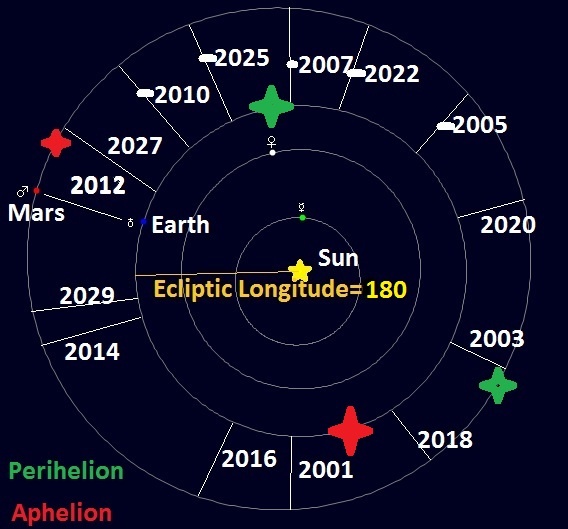
Mars Opposition Season 2020
What’s more, all opposition seasons are not equal, especially in the case of Mars. If the Earth and Mars orbited the Sun in tidy circles, all oppositions of the Red Planet would appear the same. The Red Planet travels from an aphelion of 1.66 Astronomical Units (AU) (154.8 million miles/249.2 million kilometers) to a perihelion of 1.382 AU (128.4 million miles/206.7 million kilometers) meaning that visually, Mars can appear anywhere from 13.8” to 25.1″ across at opposition. We’re coming off of a cycle of favorable oppositions since 2003, with Mars getting successively farther away with each pass. In 2020, Mars passed perihelion on August 3rd, and Mars is closest to the Earth at 62 million kilometers distant on October 6th. Mars will appear 22.6” across on that date, and only shrinks to 20.1” by the end of October.
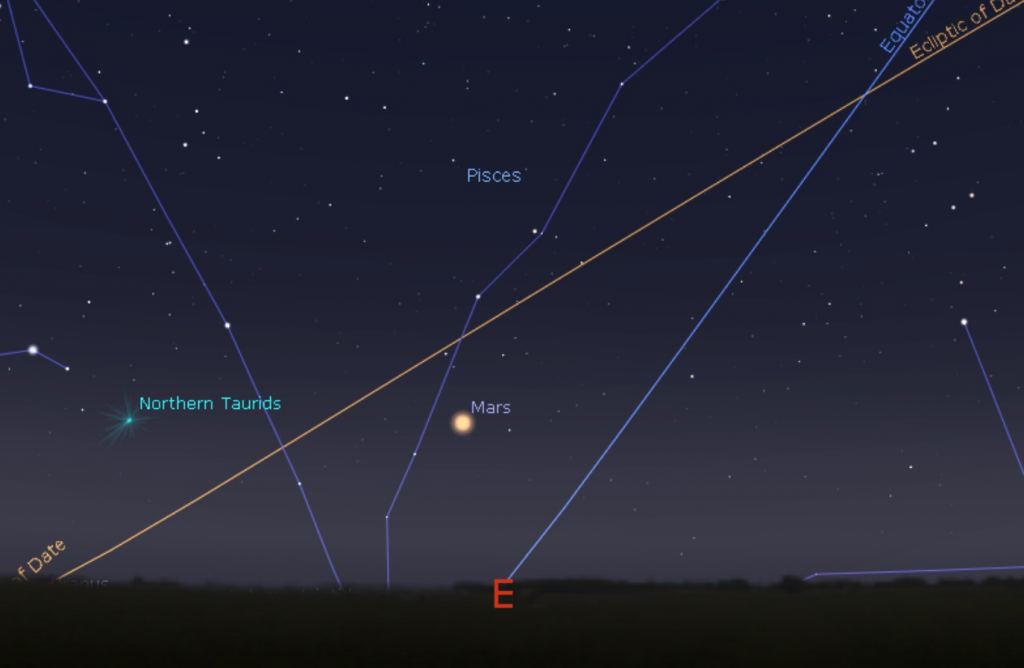
This is the best until opposition for Mars until the 2035. Passes will get more unfavorable until the 2027 opposition of Mars near aphelion, after which, oppositions will start to slowly get better again.
…and no, Mars will not appear to be ‘larger than the Moon,’ during this or any other opposition… this urban legend-turned-chain email started in 2003, and just won’t die.
Also, keep an eye out for the final occultation of Mars in a series for 2020 on the evening of Oct 2/3rd for the southern tip of South America—the rest of us will see a near miss. This is very near opposition on the 13th, and the Full Harvest Moon on October 1st. The Moon won’t occult Mars again until April 17, 2021.
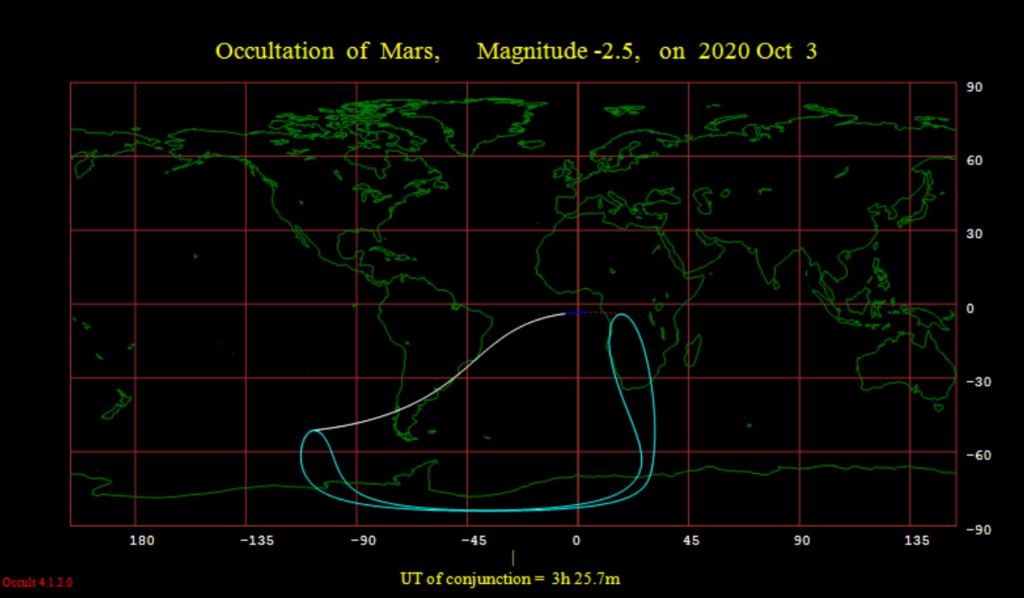
Opposition is the very best time to observe Mars, and detail seems to pop right out at the eyepiece of a telescope, turning Mars into a real world. In October 2020, the southern hemisphere is tipped forward, as the northern hemisphere just passed the winter solstice in September. Mars is also crossing the constellation Pisces the Fishes in October, making this opposition equally favorable for either hemisphere. The very best time to observe Mars near opposition is around local midnight, when the planet rides highest out of the murky atmosphere near the local horizon.
Percival Lowell made claims of sighting spurious canals during the favorable oppositions in the late 19th/early 20th centuries, observing the Red Planet with the 24”-inch Clark Refractor at the Lowell Observatory in Flagstaff, Arizona, and creating a media sensation in the process. Asaph Hall discovered the Martian moons of Phobos and Deimos during the opposition of 1877, using the 26”-refractor newly installed at the U.S. Naval Observatory in Washington D.C.
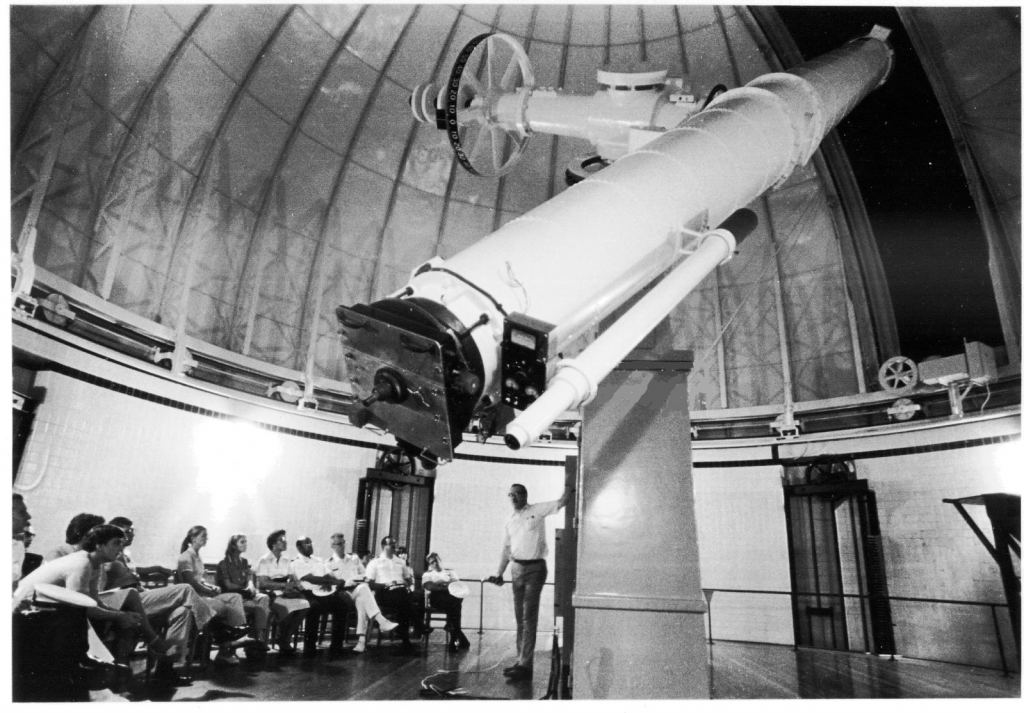
Mars will shine at magnitude -2.6 near opposition. You can actually see Mars in the daytime near opposition… if you know exactly where in the sky to look for it. The October 2nd/3rd lunar occultation is a good time to try, using the nearby Moon as a handy guide.
While we call Mars the ‘Red Planet,’ it can appear anywhere from a pumpkin-orange (a suitable Fall hue) to a saffron-yellow. A yellowish tint may indicate that a planet-wide dust storm is underway, and this can even be apparent to the naked eye. While it’s fascinating to watch one evolve, dust storms are bad news during opposition, as they can obscure surface details, making Mars appear featureless.
The first feature that will pop out at the eyepiece are the white dollops of the polar caps. A Martian day is only just over 37 minutes longer than the Earth’s, meaning that if you observe Mars at the same time on successive evenings, you’ll very nearly see the same longitude of the planet, shifted only slightly from one night to the next.
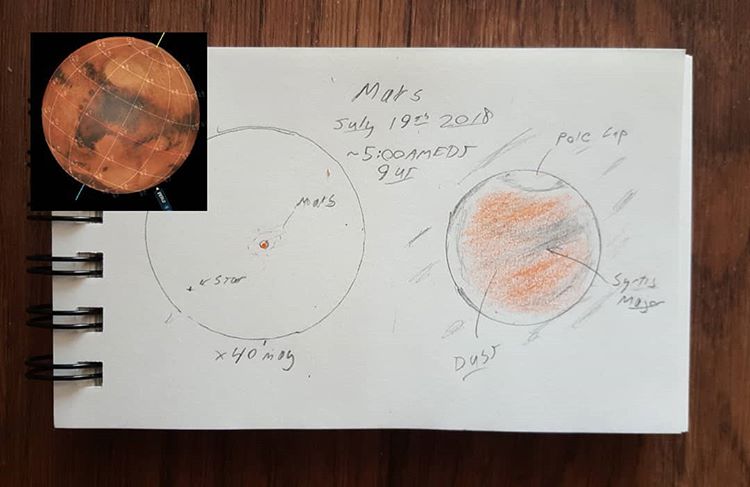
Opposition is also a great time to try and spot the Martian moons Phobos and Deimos. Shining at magnitude +11.3, Phobos orbits Mars once every 7.7 hours and can journey 20” from the disk of Mars, while +12.4 magnitude Deimos orbits Mars once every 30.4 hours, and can venture 66” from the Red Planet. The moons would be a cinch to see… if brilliant Mars wasn’t nearby. Use the PDS Rings Node site to see when the moons are at greatest elongation from Mars, and an occulting bar eyepiece is also handy to block Mars from view and aid you in your quest.
The season leading up to opposition is the best time to launch missions to Mars, as it requires the least fuel and the shortest duration. In 2020, three missions are en route for arrival in early 2021: The United Arab Emirates’ Mars Hope, NASA’s Perseverance rover, and China’s Tianwen-1 orbiter, lander and rover package.
Have a telescope, webcam and laptop? It’s easy to image Mars, using planetary imaging and stacking software… these days, folks are getting amazing results with nothing more than a smartphone camera aimed at an eyepiece.
Mars last night!?? Stack of 500 iPhone video frames taken through my 8” telescope. #shotoniphone11pro https://t.co/iq8aLitxcs pic.twitter.com/tixsWk9v0P
— Andrew Symes (@FailedProtostar) September 20, 2020
Don’t miss the Red Planet in 2020… perhaps, has Halloween season nears, a little War of the Worlds is in order, to set the observing mood.
Lead image: Mars, leading up to opposition 2020. Image credit and copyright: Roger Hutchinson.

